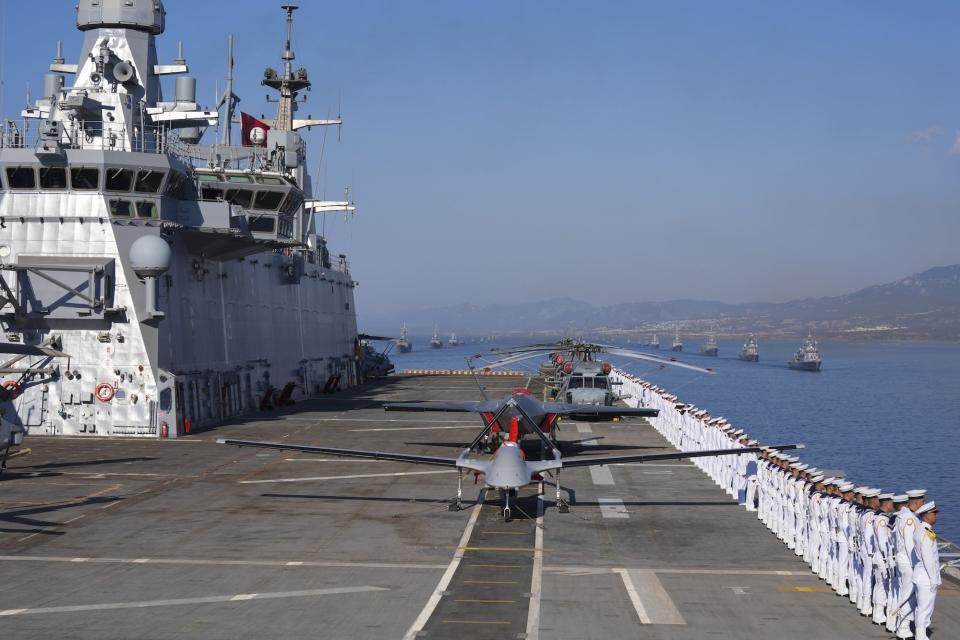-
Turkey and Iran are building aircraft carriers for drones to project their naval power.
-
These drone ships offer new possibilities, but are still not nearly as powerful as traditional flat-planes.
-
“They still won’t be as good as a warship, but they could be good enough,” one expert said.
Turkey and Iran say they are building navies that can project energy far from shore. Central to these ambitions are motherships for aerial drones.
These regional powers are betting that they can build a replaceable air force without the huge expense of aircraft carriers, fighter jets and pilots trained to fly them.
“I think both navies will use these carriers in the same way: to attack enemy forces and facilities on land and enemy ships in coastal areas where they can be picked up by radar and spotters from shore,” said Bryan Clark, a naval expert at the Hudson Institute think tank.
Naval experts agree that drone ships offer new capabilities, but point out that they fall far short of the aircraft carriers and amphibious assault ships that the best navies operate. An amphibious flat-top that can launch helicopters and fighter jets with short takeoff and landing times was indeed Turkey’s original vision, but things didn’t go according to plan.
The US barred Turkey from acquiring the F-35B, the jump-jet version of the Joint Strike Fighter that it planned to fly from the deck of its flagship TCG Anadolu. As a result, Turkey made some changes in the final stages of the Anadolu’s construction, ultimately transforming it into a unique drone carrier.
Turkey developed the Bayraktar TB3 naval drone for the Anadolu and claims that the unmanned Kizilelma fighter jet it is developing could also operate with it. Ankara has plans for a second, larger vessel like the Anadolu, which it claims will have even more domestic components.
All this is part of Turkish President Recep Tayyip Erdogan’s plans for a naval force that will “protect our rights and interests in overseas impact zones on our national aircraft carrier,” as he said in a speech on August 24.
Neighboring Iran is also busy developing ships that can carry drones. These ships are much more makeshift than the Anadolu.
Undated imageslikely taken this year, showed additional construction work on the Iranian Revolutionary Guards’ Shahid Bagheri drone carrier, which resembles a Soviet aircraft carriernotably with its trademark ski jump. Unlike the Anadolu, which was a purpose-built warship from the start, the Shahid Bagheri is a modified container ship with a sloping flight deck for launching drones. It can also carry helicopters and small fast attack boats.
In May, Iran’s other drone-carrying ex-container ship, the Shahid Mahdavi, completed a 39-day voyage in the Indian Ocean. During that voyage steamed near Diego Garciahome to a major U.S. base. Iran’s IRGC boasted that the trip represented “a message to Americans that we can reach the closest point to you.” The IRGC also test-fired ballistic missiles from the deck of the Shahid Mahdavi in February to demonstrate the range of her naval firepower.


‘Cheap solutions’
While nothing can compare to the US Navy super carriersShips such as the Shahid Bagheri and Shahid Mahdavi could still have a strategic impact.
Professor Shaul Chorev, head of the Maritime Policy and Strategy Research Center of Israel’s National Center of Blue Economy, compared these homemade Iranian ships to those of the Israeli Navy.
“Unlike us, they use cheap solutions,” said Chorev recently told Haaretz. “They take a merchant ship, equip it with a flight deck and turn it into a poor man’s helicopter or drone carrier. It suits all their needs.”
“Ultimately, such drones – and eventually unmanned surface vessels – could be placed in strategic locations, allowing them to do what our Sa’ar 6 corvettes can’t.”
While these vessels are not as powerful and versatile as flat-bottomed ships, they do increase the ability of Turkey and Iran to project their naval power.
Clark, a senior fellow at the Hudson Institute, believes these ships will “elevate” both navies by giving them “a reach well beyond their own region.”
Nevertheless, he pointed out some serious shortcomings.
“Drone carriers won’t really make the Iranian Navy a ‘blue water force,’ because the IRIN (Islamic Republic of Iran Navy) still doesn’t have the broad surveillance and targeting capabilities needed to use drones against enemy ships or the supply ships that are en route to keep ships at sea,” Clark told Business Insider. “The Turkish Navy has those capabilities and is already a blue water force.”
These drone carriers also have inherent shortcomings compared to other navies’ aircraft carriers and amphibious assault ships.
“These carriers initially won’t have the features that are needed in a true amphibious ship, such as a well deck or transport helicopters to deploy troops, medical facilities and troop docking, and repair facilities,” Clark said. “But they could add some of those capabilities and be a version of an amphibious ship.”
“They still won’t last as long as a warship, but they may be good enough for the situations these countries may find themselves in against regional competitors,” Clark added.
These efforts are also not equal. Andrew “Woody” Lewis, a retired U.S. admiral who is a distinguished fellow at the Center for European Policy Analysis, sees Iran’s attempts at naval power projection as second-rate compared to Turkey’s.
“Iran’s intention to project power far from shore with Shahid Bagheri’s drones does not give them the ability to gain control of the sea in a blue-water environment,” Lewis, a former commander of the U.S. 2nd Fleet, told BI. “It is nothing more than an attempted terrorist attack in open waters without the ability to hide behind surrogate forces on land.”
“Iranian aspirations are in no way comparable to the tremendous capabilities of the United States and our allies to modify the payloads of large and medium-sized naval platforms to project their power in a clear-water environment,” Lewis said.
Read the original article at Company Insider







